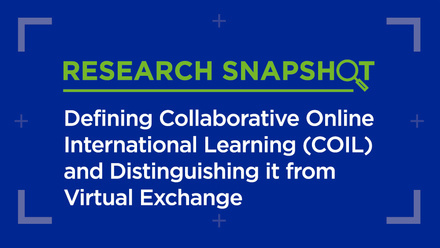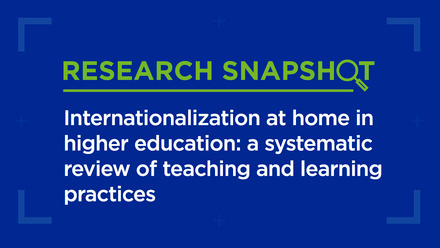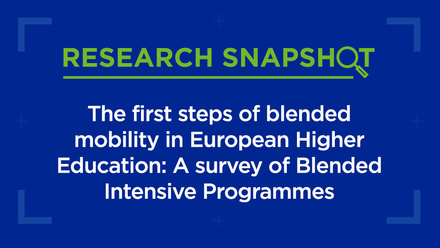Words matter: why we should stop talking about ‘virtual mobility’

As Andy Molinsky articulated in the Harvard Business Review, "if you’re not outside your comfort zone, you won’t learn anything." This sentiment goes to the heart of what we do in internationalisation of higher education. If our goal is to bring international and intercultural competences to our students, we have to nudge them out of their comfort zone. No progress without some friction.
For a large part of the modern era of internationalisation of higher education (which we could argue started with the launch of the Erasmus programme in 1987), ‘internationalisation’ was widely considered to be a synonym of (physical) mobility. Through the late 1980s and most of the 1990s, before widespread adoption of the internet and digital technologies, the only way to get significant international and intercultural experiences was indeed physically traveling to another country. This thinking has left deep traces in our minds until today.
Reflecting on the ‘why’
Of course, we soon realised that the travel itself could not be the end goal. The ultimate ‘product’ of education is expressed in the competences acquired by the students: knowledge, skills and attitudes. International mobility of students and staff is a purposeful investment, yielding rich international and intercultural competences; this is what we proclaimed.
We soon realised that the travel itself could not be the end goal
Asking alumni what they really gained from their international experience brings out stories about how they learned to survive and to be happy abroad. How unexpected encounters had lasting effects. About the person they became by going outside their comfort zone. It was about finding creative solutions for unexpected problems. Failing. Working out misunderstandings. Starting again. Becoming more self-confident, but also open and caring. Making new human connections. These are life-changing experiences. Almost without exception, their stories are about new attitudes and skills, and much less about knowledge. Crucially, these attitudes and skills were, for a very large part, built outside the classroom. The thing is: simply crossing national borders does not lead to significant learning in and of itself; but meaningful human interactions, without exception, do.
Internationalisation at Home and virtual exchange
In the last 15 years, a lot of valuable work has been done on developing Internationalisation at Home (IaH), with the express goal of bringing international and intercultural competences to all students. The thinking is that if we want to prepare our students for becoming effective, self-confident professionals and responsible citizens in our superdiverse and globalised society, we can’t keep focusing our efforts only on the minority of students who are willing and able to study abroad. In fact, those students who engage in physical mobility are probably the ones who need it the least.
Those students who engage in physical mobility are probably the ones who need it the least
After a period of organic, gradual growth, virtual exchange (VE) or Collaborative Online International Learning (COIL) suddenly received a huge boost in interest when physical mobility was disrupted by the COVID-19 pandemic. See the excellent blog post by Jos Beelen and Robert O’Dowd for a clear and useful reflection on the essence of Virtual exchange and Internationalisation at Home: navigating the terminology. COIL/VE has quickly gained much wider recognition for its potential as a hugely impactful and efficient way to build international and intercultural competences, although a careful, deliberate and well-supported approach is needed to avoid the many possible pitfalls.
Through well-designed and purposefully-implemented COIL experiences, students are effectively brought out of their comfort zone, and put in a position where their academic success depends on their productive and efficient collaboration with peers in other countries. The deeply collaborative process at the heart of COIL/VE, both at the level of the students and of the teaching staff involved, is the crucial element. This intense interaction in the framework of their formal course work often leads to deep personal connections as well, albeit online.
Virtual mobility
It is precisely this emphasis on (sometimes challenging) international and intercultural collaboration and forging of productive personal relationships that is often missing from so-called ‘virtual mobility’, which is now (as opposed to ‘virtual exchange’), generally taken to mean simply following one or more online courses from a host university in another country and receiving academic recognition of the credits acquired. I understand where this interpretation of ‘virtual mobility’ comes from: taking courses abroad and transferring credits are the traditional formal features of student mobility, and if you take the physical mobility out of the equation, this is what you are left with. The huge problem is that in traditional (physical) student mobility, as explained above, the ultimate benefits in terms of competences don’t generally come from the formal curriculum, and in so-called virtual mobility, there are no opportunities ‘outside the classroom’.
It is precisely this emphasis on international and intercultural collaboration that is often missing from so-called ‘virtual mobility’
Furthermore, the presence of a meaningful ‘international classroom’ experience is far from obvious in a context of the average online course. While there are certainly good examples to the contrary, many online courses simply do not require collaboration or meaningful interaction between the students. Therefore, engaging in ‘virtual mobility’ in this sense, ie simply following online courses, is in no way guaranteed to be a useful internationalisation experience in terms of broader competences. ‘Virtual mobility’ in this sense is a misguided term, because in practice it does not necessarily imply the benefits associated with physical mobility. Virtual Exchange/COIL, on the other hand, if executed properly, has the acquisition of rich international and intercultural competences at its core.
The situation becomes truly problematic when there is an implied hierarchy, and virtual mobility (in the sense explained above) in effect receives more recognition (and also potentially funding) than COIL/VE. This can happen when virtual mobility – thanks to the formal elements of enrolment as an ‘exchange student’ in the host university and the transfer of credits to the home university – would ‘count’ towards goals and benchmarks for internationalisation, such as the EU learning mobility benchmark of 20% mobile students and various national quantitative benchmarks, whereas COIL/VE (which generally does not require formal transfer of credits between institutions) would not. It is similarly problematic if funding which is normally reserved for physical mobility can now (exceptionally or permanently) be used for virtual mobility, but not for VE/COIL.
Alternative terms, alternative approaches
While it may be useful for other reasons, following online courses from a university in another country is not in itself a very rich or effective form of internationalisation. Why then do we call it ‘virtual mobility’? I would propose to reserve the term ‘mobility’ for its original meaning: physically traveling to another country. Following online courses simply has nothing to do with mobility.
I would propose to reserve the term ‘mobility’ for its original meaning: physically traveling to another country
I argue therefore that ‘virtual mobility’ is a misleading and useless term. We don’t need it. What ultimately matters are intense, purposeful, meaningful interactions between students from diverse backgrounds, and between students and teachers. These interactions can happen online or face-to-face. While mobility remains an essential and incredibly valuable tool in this respect, it is definitely not the only one. We have a rich toolbox of impactful activities we can develop in our field of internationalisation of higher education. Calling some of them ‘virtual mobility’ – as being somehow equivalent to physical mobility – is not a useful distinction. Let’s focus instead on maximising the impact of what we do, both face-to-face and online.






